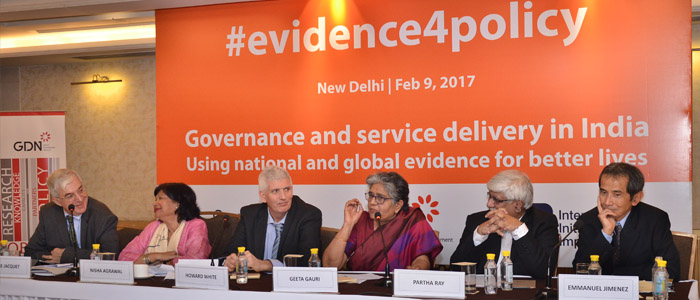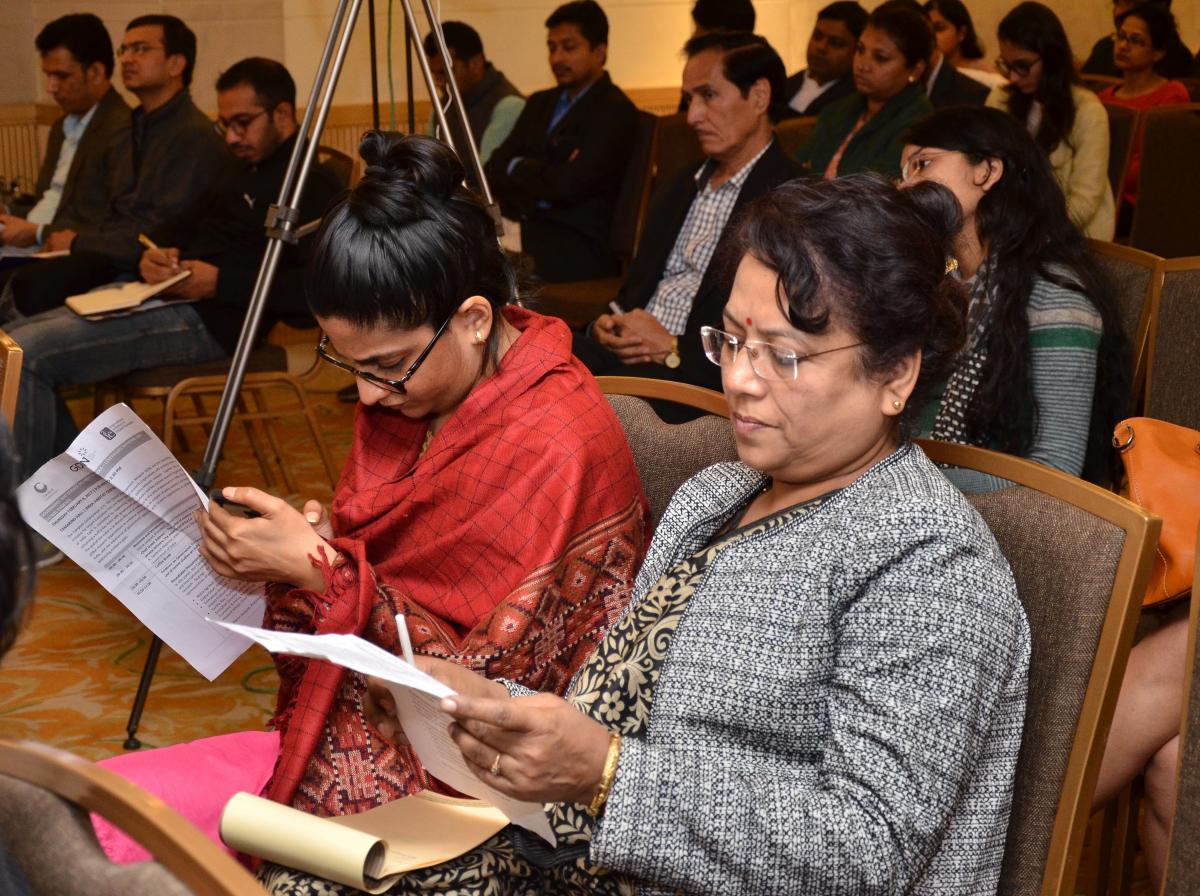
The need for “good governance” as a bastion for development is promoted by policymakers, development actors and governments across the world. Now a national priority in India, good governance relies upon accountability and sound, relevant data. In other words, the use of evidence for policy.
A half-day conference in New Delhi on 9 February, 2017 brought together experts from government institutions, non-governmental organizations and national research organizations to discuss the use of evidence in informing policy debate and decisions in India, and the gaps that limit the practice of using evidence for policy.
The event was organized by the Global Development Network (GDN), the Campbell Collaboration and the International Initiative for Impact Evaluation (3ie) – three global research organizations committed to supporting evidence-based, policy-relevant research.
Here are some of the highlights from the event.
Evidence – the what and the how
What is at stake when we speak about using evidence to inform policy? GDN President Pierre Jacquet’s opening question considered the value of evidence in decision making, and its role in determining policy outcomes and impacts. In its most basic definition, collecting evidence is about finding out what works – and what doesn’t – in specific contexts and times, he said. At the fundamental level, evidence is about linking processes with results, helping us to move from a “what” works question, to a more complex and operational question of “how” things work. The latter – although critical – receives far less attention, he argued.
Informed #governance is a "crucial ingredient in the fight against poverty and inequality" says @jacquet_pierre @campbellreviews @3ieNews pic.twitter.com/p6jPZhT17C
— GDN (@GDNint) February 9, 2017
Building a network of champions
Chief Guest, A. Santhosh Matthew, Chair of the Teachers Education Council in the Ministry of Human Resource Development and former Joint Secretary in the Ministry of Rural Development, Government of India, established the need for a strong, unambiguous link between evidence and policy, and introduced some guiding principles on how to get there. Central to these principles, he argued, is the need to “build a network of champions” to take the agenda for evidence-based research for policy forward. Watch the entire keynote address here.
Evidence for Impact isn't ticking the boxes, it's about building a network of champions #evidence4policy @GDNint @3ieNews @campbellreviews pic.twitter.com/4z0gA0VORX
— GDN (@GDNint) February 9, 2017
@GDNint @ASanthoshMathew suggests that the use of evidence in policy requires conjunction of 3 things: evidence, champions, and timing
— Pierre Jacquet (@jacquet_pierre) February 9, 2017
A culture of evidence
In his opening remarks, A. Santhosh Matthew also promoted the need to “build a culture of using evidence” noting the requirement for resources, training and supporting literature as tools to cultivate an environment in which evidence is systematically used by policymakers. To do this, researchers need to be equipped to "spot opportunities" to bridge the gap between evidence and policy, he said.
Look for 'evidence moments': provide guide to what evidence needed and possible entry point for evidence Santhosh Matther #evidence4policy
— Howard White (@HowardNWhite) February 9, 2017
Harnessing local research
A. Santhosh Matthew stressed the importance of contextualized, localized research. Research that is not geographically-relevant or context-specific, he argued, cannot inspire meaningful policy decisions or hope to achieve effective impacts.
@ASanthoshMathew: good quality research and context are often separated. Need geographical engagement for policy impact #evidence4policy
— Emmanuel Jimenez (@eyjim2) February 9, 2017
Factual versus counterfactual
In the first roundtable discussion, chaired by GDN President Pierre Jacquet, distinguished representatives of government agencies and research institutions shared insights on recent research findings on governance and service delivery in India. Chief Executive Officer at Campbell Collaboration, Howard White opened the discussion raising a point of distinction between “factual” and “counterfactual” evidence. Relating back to Pierre Jacquet’s opening remarks about examining not only “what works” but “how it works,” White suggested that the “what” question must be answered with counterfactual evidence. He encouraged the growth of randomized control trials and experimental studies to test the reliability of particular programs.
It's important to distinguish factual #evidence and counterfactual evidence @HowardNWhite #evidence4policy @3ieNews
— Diana Lopez-Avila (@dmlopeza09) February 9, 2017
Using evidence for policy – the example of the Philippines
Executive Director of 3ie, Emmanuel Jimenez discussed the example of the implementation of conditional cash transfers (CCTs) in Mexico and its wide-reaching effects on CCT programs across East Asia. The Philippines, one of many East Asian countries that has historically viewed social welfare programs with suspicion, was convinced by research demonstrating the successes of CCTs in Mexico to implement and scale up its own version of the program, he explained.
3ie's exec dir @eyjim2 says hard evidence can lead to sustainable policy reform #evidence4policy
— 3ie (@3ieNews) February 9, 2017
Data versus judgment
Partha Ray, Professor of Economics at IIM Calcutta and former advisor to the Executive Director of IMF India, drew on his experience as a macroeconomist, and said that survey data is increasingly being used in the field. He outlined the issue of incomplete data faced by macroeconomists, citing the example of national account statistics in India and the problematic coverage of GDP data. Policymakers must use their own judgment to understand what the data is telling them, he cautioned.
A macroeconomist is guided by imperfect data. Interpretation needs judgement: Partha Roy #evidence4policy @GDNint @3ieNews @campbellreviews pic.twitter.com/AjxEbehuG4
— Madhuri Dass (@MadhuriDass) February 9, 2017
Micro versus macro
Geeta Gouri, former member at the Competition Commission of India (CCI), remarked on the importance of micro versus macro data and its impact on development. A critical factor, she argued, is that regulators require “the kind of [micro] evidence determined by law.”
The law demands a “certain kind of evidence,” she said. “... very rarely do they accept circumstantial evidence.”
She also highlighted the intractability of large amounts of macro data, as seen in national accounts. “They are at such a macro level; you never know what’s happening on the ground.”
Large amount of macro data that is scattered, never used, says Geeta Gouri #evidence4policy @3ieNews @campbellreviews
— GDN (@GDNint) February 9, 2017
Evidence, meet empathy
Expanding the discussion, Nisha Agrawal, Chief Executive Officer at Oxfam India, raised some insightful points about combining the use of evidence with empathy and emotion when working for social and policy change. She said that while hard evidence provided the basis for advocacy campaigns, there is a need to appeal to human emotion and capacity to empathize with the cause. The figure that the wealthiest eight people in the world own as much wealth as the bottom half of the global population, she illustrated, is both evidence-based and deeply evocative, and has been useful in garnering support Oxfam’s campaign on inequality.
@nishaagrawal007 What we need is the combination of #empathy #emotions #evidence for successful implementation of programs #evidence4policy
— Ashrita Saran (@AshritaSaran) February 9, 2017

Seventy nine people attended the half day conference in New Delhi.
Rounding up your stakeholders
In the second roundtable, chaired by Howard White, Indrani Gupta, Professor and Head of Health Policy Research at the Institute of Economic Growth, and Rohini Somanathan, Professor of Economics at the Delhi School of Economics, discussed cross-cutting research priorities, critical gaps and avenues for collaboration in India.
Indrani Gupta offered insights from her experiences – both positive and negative – of using research in the health sector. An important factor that distinguishes the health sector from others, Gupta illustrated, is that it is largely driven by a wide variety of stakeholders with competing interests, which can either prevent or enable policies from being implemented. To overcome these barriers, Gupta promoted the need for stronger multi-stakeholder collaboration and for governments to partner with autonomous research institutes.
Conflicting evidence confuses rather than informs: Indrani Gupta #evidence4policy @GDNint @3ieNews @campbellreviews pic.twitter.com/j5Fe3hUxhG
— Madhuri Dass (@MadhuriDass) February 9, 2017
Indrani Gupta, IEG: Research champions can come from govt or NGOs. Partnerships imp for carrying out high quality research #evidence4policy
— Radhika Menon (@MenonRadhi) February 9, 2017
Beware, the politics of evidence
Rohini Somanathan addressed a question from the audience about the ‘politics of evidence,’ where the ability to influence policy is constrained by a need to access ‘inner policy circles’, that can be characterized by glamour and status. However, she is optimistic about the future, due to the willingness she has witnessed from high-level policymakers and researchers to engage in more ground-level discussions around evidence for policy.
The more we talk about it, the less politics of evidence there will be Rohini Somanathan @GDNint @3ieNews @campbellreviews #evidence4policy pic.twitter.com/37WTRhBxy2
— Madhuri Dass (@MadhuriDass) February 9, 2017
Success is participatory
Also in response to an audience question, this time from development guru Robert Chambers, Somanathan also stressed the importance of participatory approaches to target government programs. For example, poverty reduction programs can achieve far greater results when targeted through participatory methods, she said.
Rohini somnathan on participatory approach, it works well with #poverty targeting #evidence4policy
— Ashrita Saran (@AshritaSaran) February 9, 2017
Connecting the dots
Emmanuel Jimenez wrapped up the event noting the key highlights from the day’s discussions. Creating an environment in which evidence is used for policy, he concluded, demands a confluence of enabling factors, including high quality, contextual research; multi-stakeholder engagement among policymakers and researchers; and transparency. To do so, he reiterated, will require a network of champions to connect the dots – to close the gap between evidence and policy.
Emmanuel Jimenez @3ieNews :
We need to ensure better engagement to align incentives for #evidence4policy among different stakeholders— GDN (@GDNint) February 9, 2017





